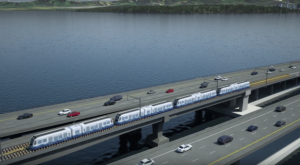
Seattle already has the world’s longest floating bridge, and next month, it’s going one step further: building the world’s first floating light rail line.
The undertaking is part of a $3.7 billion project to build a light rail corridor linking Seattle to the city of Bellevue on the east side of Lake Washington by 2023. It’s a tricky endeavor; the floating bridge has to withstand the pressure of two pairs of 300-ton trains traveling at speeds of up to 55 mph. To make it happen, the transit agency Sound Transit is turning to cutting-edge earthquake technology. With 50,000 riders expected daily, there’s absolutely no room for mistakes, the Seattle Times reports:
A derailed train would sink 200 feet to the lake bed. If track components break or wear out, transit service would be halted for maintenance, or subjected to slowdowns.
Still, this isn’t a city that shies away from massive infrastructure ventures. Its replacement project for the Alaskan Way Viaduct introduced us to Bertha, the world’s largest tunnel boring machine, which emerged from its controversial years-long trek under downtown Seattle earlier this year. And as I reported in December, it’s also working on a new “flexible” bridge designed to ride out an earthquake with little to no damage.
Seattle is also home to four of the world’s longest floating bridges. One of them, the Lacey V. Murrow Bridge, spanning more than 6,600 feet along Interstate 90, connecting Seattle to nearby Mercer Island. (The original version of that bridge was the longest floating bridge in the world until 1963, when the city completed a 7,500-foot span of State Route 520 just a few miles north. In 2016 the city replaced SR 520 with a 7,700-foot bridge, which is the current record holder.)* Come June, its two reversible HOV lanes will be replaced with railway tracks, and the rest of the bridge will be reinforced to sustain the added weight and movement. The light rail, according to the Times, will be 30 percent heavier than what the bridge is currently designed to withstand.
To grasp the complexity and the immense challenge ahead, it helps to understand how these bridges work. The I-90 bridge, as it’s better known, is essentially supported by more than two dozen massive pontoons—watertight concrete blocks filled with air. Buoyancy helps these structures stay afloat, and maintenance checks are strenuously done to prevent any cracks. According to the Times, some of the gravel within the pontoons will be removed to prevent the rail cars from throwing off the balance, thereby keeping buoyancy.
The more significant challenge is at the hinges that join the floating and fixed sections of the bridge together. Below the deck, pontoons are linked together, and steel cables anchor them to the lake bed, which helps keep them from violently wobbling during strong winds and fierce waves.
Continue reading in City Lab
Originally written by Linda Poon